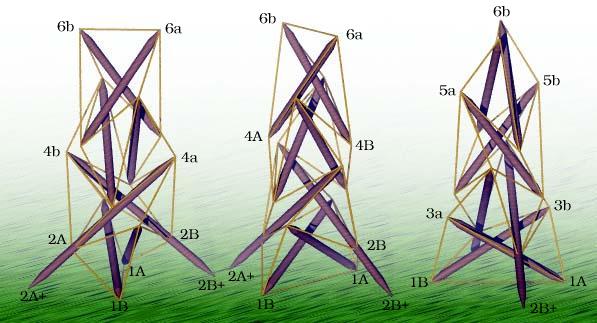
Three Views of the Bean Teepee
structure file: chain/x2l4chain1a.rc variable file: chain/x2l4chain1a.dat stress-strain chart file: v02oct_s/evans.ssc cross-section table: chain/x2l4chain1a.cst digit list file: src/standard.dls |
Member Descriptions
[name, end point names, weight (if in objective function),
second power of length (if a constraint), member category,
Obj/Con/Exc (put in objective function, use as a constraint or
exclude from computations), flags]
For assembly purposes, only the name and end point names are
of interest. The other information may be of interest after
A Practical Guide to Tensegrity Design has been consulted.
first stage
<Member> end1 p1A p1B 0.0 sqr(1.3*1.24030) 4 Con *
<Member> st13 p1A p3a 0.0 sqr(1.685867) 1 Con CalcClear Inelastic *
<Member> side1a p1A p3b 1.0 0.0 3 Obj *
<Member> side1c p1A p2B 1.0 0.0 3 Obj *
<Member> gird1a p2A p3a 0.0 sqr(1.0) 2 Con *
<Member> gird1b p2A p3b 0.0 sqr(1.0) 2 Con *
second (complete) stage
<Member> st24 p2A+ p4a 0.0 sqr(1.685867*1.4146184) 1 Con CalcClear Inelastic *
<Member> side2a p2A p4b 1.0 0.0 3 Obj *
<Member> side2b p4a p3a 1.0 0.0 3 Obj *
<Member> side2c p2A p3B 1.0 0.0 3 Obj *
<Member> gird2a p4a p3B 0.0 sqr(1.0) 2 Con *
<Member> gird2b p4a p3A 0.0 sqr(1.0) 2 Con *
third (complete) stage
<Member> st35 p3A p5a 0.0 sqr(1.685867) 1 Con CalcClear Inelastic *
<Member> side3a p3A p5b 1.0 0.0 3 Obj *
<Member> side3b p5a p4a 1.0 0.0 3 Obj *
<Member> side3c p3A p4B 1.0 0.0 3 Obj *
<Member> gird3a p5a p4B 0.0 sqr(1.0) 2 Con *
<Member> gird3b p5a p4A 0.0 sqr(1.0) 2 Con *
fourth and last stage
<Member> st46 p4A p6a 0.0 sqr(1.685867) 1 Con CalcClear Inelastic *
<Member> side4a p4A p6b 1.0 0.0 3 Obj *
<Member> side4b p6a p5a 1.5 0.0 3 Obj *
<Member> end2 p6b p6a 0.0 sqr(1.24030/1.3) 4 Con *
In-Situ Member Lengths
These are the lengths of the members when they are in place
and prestress is applied. The strut lengths are from
screw-eye center to screw-eye center, as are the tendon lengths.
These values are in model units.
end1: 1.61239 st13: 1.68587 side1a: 0.923189
side1c: 0.953076 gird1a: 1 gird1b: 1
st24: 2.38486 side2a: 1.17827 side2b: 0.97929
side2c: 0.846298 gird2a: 1 gird2b: 1
st35: 1.68587 side3a: 1.38778 side3b: 0.998633
side3c: 0.832481 gird3a: 1 gird3b: 1
st46: 1.68587 side4a: 1.40257 side4b: 0.874856
end2: 0.954077
Relative Member Prestress Force Magnitudes
These values are useful for developing an assembly
strategy for the structure. The tighter tendons are much
easier to tie in place early on, while the looser tendons
can be left to the last. This information is also used
to adjust tendon lengths since the measured length of a tendon
will be shorter for a highly-stressed tendon with the same
in-situ length as a tendon which is not so stressed.
Since the symmetry transform maps end1 and end2 into
themselves, they each represent two overlapping tendons,
each with the force magnitude given below. So, the total
force is actually twice the value given for end1 and end2.
end1: 0.707352 st13: -2.58943 side1a: 0.923189
side1c: 0.953076 gird1a: 1.35245 gird1b: 1.58822
st24: -2.59752 side2a: 1.17827 side2b: 0.97929
side2c: 0.846298 gird2a: 1.39285 gird2b: 1.3656
st35: -3.56761 side3a: 1.38778 side3b: 0.998633
side3c: 0.832481 gird3a: 1.10818 gird3b: 1.4817
st46: -2.98368 side4a: 1.40257 side4b: 1.31228
end2: 0.649404
Average tendon force magnitude: 1.13665
Construction Lengths (in inches, 16ths and 32nds)
The construction length of a tendon is less than the in-situ
length since when the tendon is measured off it isn't under
any prestress force. The construction length for a member
represents the distance between the locations where it
departs from the hub. The struts were cut from
1-inch by 1-inch hardwood garden stakes. The lengths below
are specified for braided nylon twine (e.g. T.W. Evans
#1 Braided Nylon Mason Line -- Item No. 12-503). Its behavior
under stress is highly non-linear, so a look-up table
was used to compute strains. It seems to be slightly more
stretchy than twine composed of twisted strands
(e.g. Wellington #18 Nylon Twine -- Prod. No. 46302).
Prestress forces were assumed to affect tendon lengths and
not strut lengths.
Average Tendon Force Magnitude (chart units)> 20
Length Scale Factor> 34/1.685867
Strut and Tendon Hub Adjustments> 0 0.5
(adjust the tendon lengths by subtracting a half inch from
both ends)
end1: 27 11 1 st13: 34 0 0 side1a: 15 15 0 side1c: 16 7 0
gird1a: 16 14 1 gird1b: 16 11 0 st24: 48 1 1 side2a: 20 5 0
side2b: 16 14 0 side2c: 14 10 0 gird2a: 16 14 0 gird2b: 16 14 1
st35: 34 0 0 side3a: 23 12 1 side3b: 17 3 1 side3c: 14 6 0
gird3a: 17 2 1 gird3b: 16 12 1 st46: 34 0 0 side4a: 24 0 0
side4b: 14 11 1 end2: 16 2 1
Material Quantities
This provides an estimate of how much material will
be needed to assemble the structure, in this case
inches of garden stake and inches of nylon twine.
The lengths must be adjusted to take into account the
fact that the strut extends past the hub and some length
of tendon is required to tie it to the strut.
These values don't take into account that two struts
have a significant extention to provide for the stability
of the structure when used as a tower.
Length Scale Factor> 34/1.685867
Strut and Tendon Adjustments> (-1) (-6)
(adjust the strut lengths by adding an inch to
both ends; adjust the tendon lengths by adding
six inches to both ends)
Cross
Type Section Quantity Count
4 0.5 133.629 4
1 1 316.194 8
3 1 589.668 20
2 1 340.121 12
Strts 316.194 8
Tndns 996.603 36

Three Views of the Bean Teepee
structure file: chain/x2l4chain1a.rc variable file: chain/x2l4chain1a.dat stress-strain chart file: v02oct_s/evans.ssc cross-section table: chain/x2l4chain1a.cst digit list file: src/standard.dls |
CONTACT:
Bob Burkhardt
Tensegrity Solutions
Box 426164
Cambridge, MA 02142-0021
USA
e-mail: bobwb@juno.com